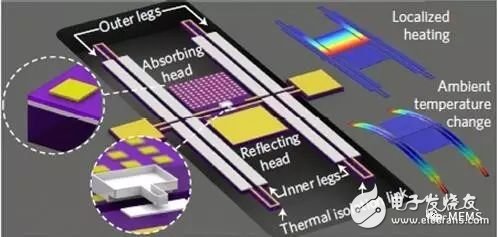Currently, advanced sensor technologies rely on active electronics for signal acquisition and processing. In order to be able to capture meaningful signals in the surrounding environment, such as specific vibrations, sounds or spectra, these sensors must be in operation at all times. This continuous operation of power consumption regardless of whether the signal is measured or not greatly limits the life of a single sensor, thereby significantly increasing the maintenance cost of the entire sensor network (or the Internet of Things) due to periodic battery replacement, and even Limits the possibility of arranging sensors in remote areas or potentially hazardous areas. According to a report by Mammus Consulting, a research team led by Matteo Rinaldi, a professor at Northeastern University, recently developed a zero-power infrared detector. This zero-power infrared detector maintains a zero-power sleep state before a meaningful signal is detected. After the infrared signature arrives at the device, it uses its own energy to drive a thermal micromechanical switch. Turning on the load circuit begins to work so that the entire sensor node is "awakened" only when a particular infrared spectrum is present. Figure 1 Schematic diagram of zero-power infrared detector [1] This zero-power infrared detector is essentially based on a micro-mechanical optical switch technology, researchers at Northeastern University called it "plasma-enhanced micro-mechanical optical switch (Plasmonically-enhanced Micromechanical Photoswitches)". The device's design cleverly utilizes physical principles and engineering techniques such as plasma metamaterials, optics, thermal conduction, mechanics, and micromachining. As shown in Figure 1, the microstructure comprises two symmetrically released cantilevers, each cantilever comprising an Absorbing head or a Reflecting head, a pair of thermally sensitive bimaterial inner arms for performing the drive, A pair of identical bi-material outer arms for temperature and stress compensation, and a pair of insulated conductors that connect the inner and outer arms. The infrared absorption end of the plasma is a metal-insulator-metal sandwich stack structure, the upper layer is a plasma nanostructure (50 nm gold patch) controlled by photolithography, the middle layer is a 100 nm silicon dioxide dielectric layer, and the lower layer is 100 nm platinum reflective layer. The absorption end also contains a high hardness bowl-shaped platinum metal contact electrically connected to an input/output terminal of the device. On the other end of the cantilever, there is a metal contact plate connecting the other input/output of the device. The distance between the platinum metal contacts and the contact plates is approximately 500 nm. Figure 2 Close-up details of the plasma infrared absorption region and metal switch contacts of a zero-power infrared detector developed by Northeastern University (scanning electron microscopy). Source: NS&NS Laboratory, Northeastern University, USA. Infrared radiation is converted into heat energy after being absorbed by the absorption end of the plasma. The heat is transferred to the inner arm of the heat-sensitive bimaterial, causing the temperature to rise and deform downward, thereby driving the platinum metal. The contact moves down. When the absorbed infrared energy exceeds the design threshold, the platinum metal contacts will eventually be connected to the contact plate to achieve electrical connection between the two input/output terminals of the infrared detector. The researchers have experimentally confirmed that by changing the lateral size of the plasmonic nanostructure, the absorption wavelength of the absorption end can be changed so that only a specific wavelength of infrared radiation can be converted into heat, thereby achieving selective photo-triggering. The experimental results also show that infrared energy as low as 500 nW can drive the mechanical switch to close, and the device can still work normally after thousands of switching cycles. Figure 3 Schematic diagram of the logic circuit composed of four zero-power infrared detectors [1] In addition, the researchers also envisaged that a plurality of mechanical optical switches with specific infrared absorption peaks can be combined into one logic circuit to realize the spectral information of the infrared source. Identification to accurately distinguish between different infrared heat sources, such as the human body, flames, and exhaust gases of various fuel engines. This technology has led to the birth of a smart sensor that is “wake-up†into the working state only when the signal to be monitored appears, and can be restored to a near-zero power sleep state after data acquisition and necessary external communication are completed. It saves the power consumption of traditional sensors during standby. Zhenyun Qian, a post-doctoral researcher who is the lead author of the research project, told Mams Consulting: "This new type of event-based passive triggering sensor can effectively extend the life of existing sensor networks to decades." He added: "This technology is expected to greatly promote the development of the Internet of Things, and can be widely used in the fields of wearable devices, drones, security, space probes, etc., especially for those that require long-term real-time monitoring, the event itself is time-sensitive but not frequent. The application scenario that occurred.†This study was funded by the N-ZERO project (near zero-power RF and sensing technology) launched by the US Defense Advanced Research Projects Agency (DARPA) at the end of 2015. The main results have recently been published in Technology. Journal of Nature Nanotechnology: [1] Z. Qian, S. Kang, V. Rajaram, C. Cassella, NE McGruer, and M. Rinaldi, “Zero Power Infrared Digitizers Based on Plasmonically-enhanced Micromechanical Photoswitchesâ€, Nature Nanotechnology, http ://dx.doi.org/10.1038/nnano.2017.147 This article Source: Nature Nanotechnology, Northeastern Uni Versity Car Screen Protector,Car Center Console Screen Protector,Car Touchscreen Screen Protector Shenzhen Jianjiantong Technology Co., Ltd. , https://www.jjthydrogelmachine.com

